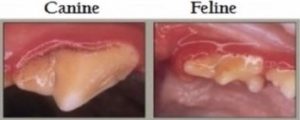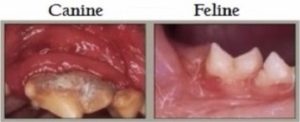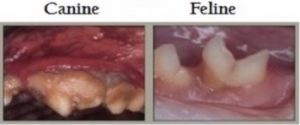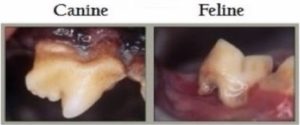February is Pet Dental Health Month…but why isn’t it year round?

February is National Pet Dental Month. It’s the time of year when veterinarians, veterinary associations, and companies that sell products for pet’s teeth, all talk about the importance of oral hygiene. It’s so true! But I ask: why not year-round? I have been a veterinarian for over 20 years, and I agree with the statistic of 90 plus percent of our pets have some sort of oral hygiene (yucky teeth) issue. I see it day in and day out, from a little tartar (hard mineralization on the tooth – typically butting up against the gumline) to covering the tooth. Rather than words, let me describe with the images below, the four stages of periodontal disease I see every day.
|
|
|
|
|
|
|
When our pets get to stages 2, 3, or 4, it is safe to say, they are hurting. The inflammation and infection seen above take a toll on the body and how your pet feels daily. I hear often from clients that their pet is acting fine. But let me be clear that even though our pets don’t complain (like we would), their rotting teeth do hurt. As you look at your pet’s teeth, ask your veterinarian what you can do to keep the mouth clean.
There are many ways to keep our pet’s teeth clean. Each pet is different, so as you read through the suggestions, go with what works best. The goal of clean teeth is
- better health,
- by the best means,
- with the least amount of effort/cost.
There are a few things to keep in mind when considering the best way to achieve excellent oral health for your pets:
- Veterinary Oral Health Council. When you look for products to help keep your pet’s teeth nice and fresh, look for the below seal of approval. Products that have this seal have been tested to reduce plaque and/or tartar. Remember the products help reduce but may not avoid the accumulation of plaque and/or tartar.
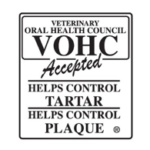
- Brushing. This is the best way to keep teeth clean but also may be the hardest to do. Only do the outside of the teeth, use a small brush, and some flavored toothpaste. Make it fun and be consistent.
- Rawhides. I am a rawhide advocate. There is some give to a rawhide as well as they soften up at the chewing end – which helps keep teeth from fracture and damage. Regular bones and very hard solid plastic-type chews are not recommended. I see enough fractured/broken teeth from pet’s use of these
- Teeth Cleaning. VOHC, brushing, and even rawhides are not able to get all the teeth looking nice and white. A cleaning is essential to get all the tartar off the teeth and afterward any combinations above to reduce accumulation and increase the interval between them is a good thing. Not all cleanings are the same. Below is an example of proper teeth cleaning procedure (Keep in mind, your pet must be sedated and intubated for the procedure):
- Physical exam: sometime before the cleaning to make sure the procedure is appropriate, and of course another one on the day of the procedure.
- Blood work: to make sure that your pet is in good health for the procedure.
- Premedication: to calm and relax as well as pain relief (if needed)
- IV catheter: to provide fluids and easier access to medications
- Intubation: A tube is placed so to prevent aspiration/inhalation of water
- Monitoring: It is important to know certain vitals while sedated
- Thorough cleaning: The teeth are scaled (removal of plaque and tartar) with an ultrasonic scaler (vibration and water)
- Charting: A full exam of the teeth and abnormalities are recorded
- Full Mouth Radiographs (X-rays): You do not know what you have unless you do xrays. There are often diseases that are not seen below the gumline. X-rays are essential for a complete evaluation. Just ask your Dentist
- Additional dental work: Often there is more work than just cleaning. Think about the pictures in stages 3 and 4-Sometimes extractions or root canals are needed.

